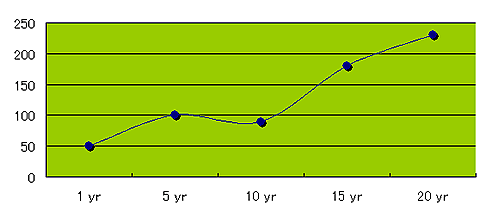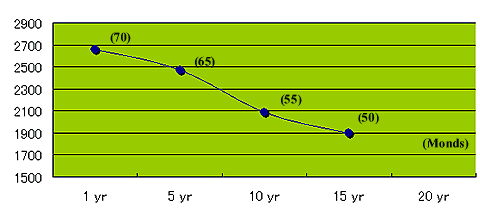As mentioned before, chemical agriculture is profit-oriented
based on the purchase of external input (chemical fertilizer,
pesticide, HYV seeds etc.) in order to get maximum out put
or yield. This is supposed to give economic benefits to farmers.
However, recently, it does not seem to work that easily. The
economic problems they face are discussed below.
3.2.1 Increase in Production Costs
In chemical agricultural practice, annual production cost
increases are unavoidable. There are mainly two reasons. One
is increase in the quantity of external inputs. (chemical
fertilizer, pesticide, etc.) Most farmers started HYV rice
cultivation in Bangladesh about 15 - 20 years ago. When they
stated using chemical fertilizer (usually only urea [N]) per
acre. Today, the have to use 200 to more than 300 kg of chemical
fertilizer (not only urea, but also, TSP [P], MP [K], etc.)
per acre and they still cannot get the same yields as before.
The reason for this is soil degradation.
The other factor in increasing casts is the increase in the
price of external inputs. The price of chemical fertilizer
was only 0.5 taka / per kg in 1972 but today it is 5.0 - 6.0aka
/ per kg. This is a more than tenfold increase in 20 years.
The cost of irrigation has also increased nearly 6 times.
Meanwhile the pri9ce of rice has only doubled in 20 years.
|
Trend of Chemical
Fertilizer consumption
(kg / acre)
|
 |
| This is a common case of farmers who
use chemical fertilizer for HYV rice production in Bangladesh
by S. Murakami 1990 |
3.2.2 Decrease in Yield
Though farmers increase the quantity of external inputs,
they cannot get as much production as before. For example,
there is the case of a farmer who started HYV rice production
15 years ago. When he started using agro-chemicals for the
fist time, he used to get about 70 mond (2,660 kg) of rice
production per acre. Nowadays, a good yield is about 50 mond
(1,900 kg) per acre. This is not a unique case but common
and almost all farmers who cultivate HYV rice using agro-chemicals
have this kind of experiences.
The reason for the decrease in yield is again, soil degradation.
It is obvious that degraded soil never produces good yield.
|
Trend of HYV Rice Production kg /
acre
|
 |
| This is a common case of farmers who
use chemical fertilizer for HYV rice production in Bangladesh
by S. Murakami 1990 |
|